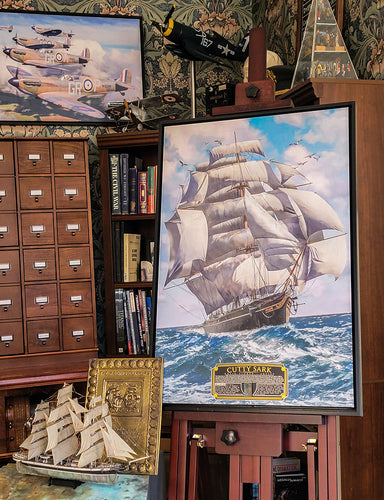This Fine Art Print by Artist Craig Tinder depicts the historic clipper ship - "Cutty Sark" on the high seas. This Limited Edition Canvas Print includes a fragment from a the Cutty Sark's original G.F. Muntz's copper hull plating and includes an engraved Certificate of Authenticity.
Details About the RELIC:
This remarkable relic originates from a 1/4-sheet copper plate crafted from G.F. Muntz's patented alloy, known as "Yellow Metal." The plate was part of the original hull cladding of the Cutty Sark, one of the world’s most famous clipper ships. The copper plating, composed of 60% copper, 40% zinc, and trace amounts of iron, was specifically designed to protect wooden ships from biofouling and to prolong their service life. Muntz metal, first patented in 1832, offered superior antifouling properties that allowed vessels like Cutty Sark to maintain their speed and durability over long voyages.
 Copper plate from the bottom of the ship's hull - used as relic on "The Cutty Sark" limited edition prints
Copper plate from the bottom of the ship's hull - used as relic on "The Cutty Sark" limited edition prints
The Cutty Sark was one of the last clippers to feature a wooden hull protected by this revolutionary metal. Ships with Muntz copper plating were less prone to damage from marine organisms, making them more efficient and requiring less maintenance. This advantage was particularly crucial during the height of the tea and wool trades, where speed and reliability were paramount.
 Copper plate from the bottom of the ship's hull - used as relic on "The Cutty Sark" limited edition prints
Copper plate from the bottom of the ship's hull - used as relic on "The Cutty Sark" limited edition prints
During the ship’s 2006 restoration, the original Muntz metal plating was removed and replaced with newly fabricated "Yellow Metal" sheets. This particular section of the original plating was salvaged before the tragic fire that engulfed the Cutty Sark in 2007. It now stands as a rare and tangible piece of maritime history, preserved from a ship that has become a symbol of 19th-century maritime innovation. This relic, from the Nauticalia LTD and Cutty Sark Trust collection, offers a direct connection to the craftsmanship and technological advances of the era that enabled the Cutty Sark to achieve its legendary speed and endurance on the high seas.
 Muntz Plating Relic included with each canvas artpiece
Muntz Plating Relic included with each canvas artpiece
The Story Behind the Print:
The Cutty Sark, a 19th-century British clipper ship, was launched in 1869 and quickly became renowned as one of the fastest ships of its time. Built specifically for the China tea trade, her primary purpose was to transport tea from China to England. At the time, tea was a highly competitive commodity, and the speed at which it could be delivered determined the market's best prices. The Cutty Sark excelled in this role, cutting through the seas with unmatched efficiency.
As steamships gained popularity, the opening of the Suez Canal in 1869 provided them with a quicker route that clippers like the Cutty Sark could not use as effectively. Despite this, the Cutty Sark remained in service and pivoted to transporting wool from Australia to England. It was during this phase that she set several speed records, cementing her legacy as one of the fastest clippers ever built.
 "Cutty Sark" Relic art by Artist, Craig Tinder
"Cutty Sark" Relic art by Artist, Craig Tinder
The ship's design reflected the peak of sail technology, enabling her to outrun many early steamships on long ocean voyages. Her sleek hull and advanced rigging made her one of the last and greatest of the clipper ships, a testament to the era when wind power still dominated international trade routes.
Today, the Cutty Sark is preserved as a museum ship, permanently moored in Greenwich, London. She stands as a symbol of the golden age of sail, offering visitors a glimpse into the rich maritime history of the 19th century. Having survived near extinction and a major fire, her restoration and display continue to celebrate the ingenuity and craftsmanship of that period.
Learn more about What is the Cutty Sark famous for (beyond just the whisky)? Click Here
To purchase or see similar items, visit here.
Commissioned by Museums, Treasured by Collectors





Share:
Fateful Advance, the story behind "The Turn to Rochefort"
Fateful Advance, the story behind "The Turn to Rochefort"